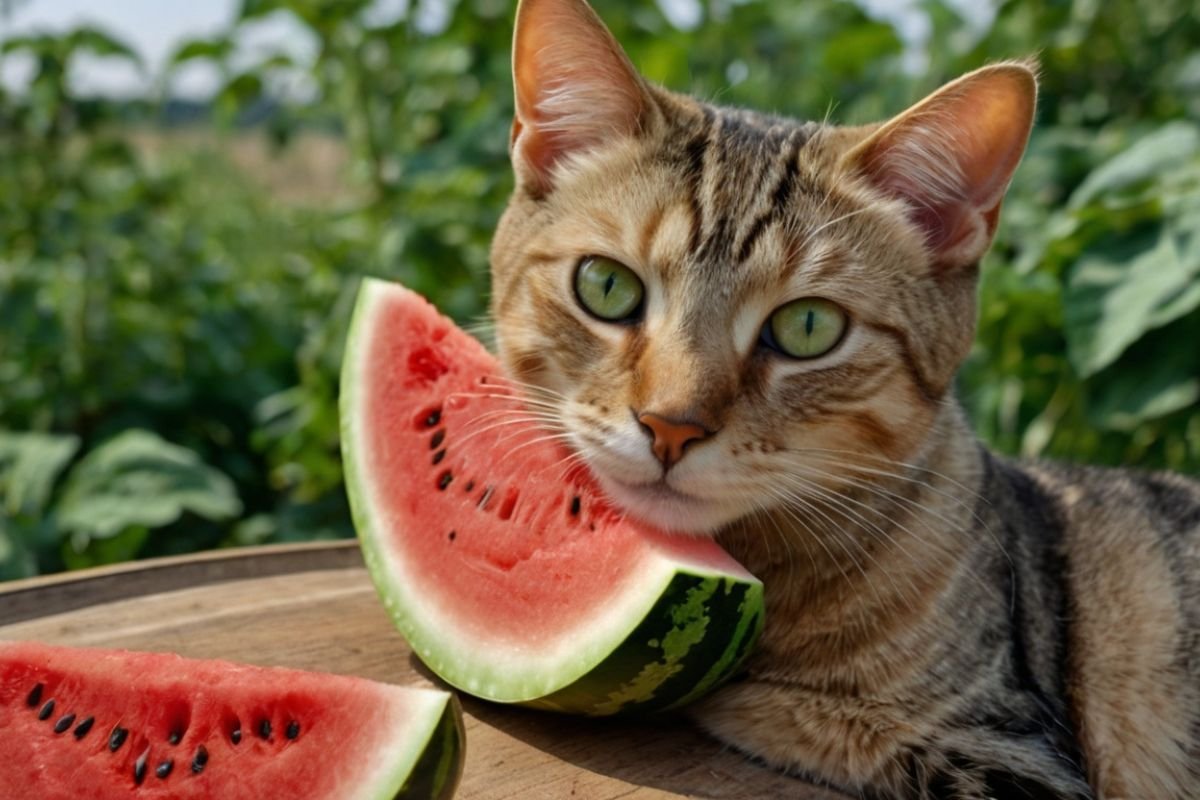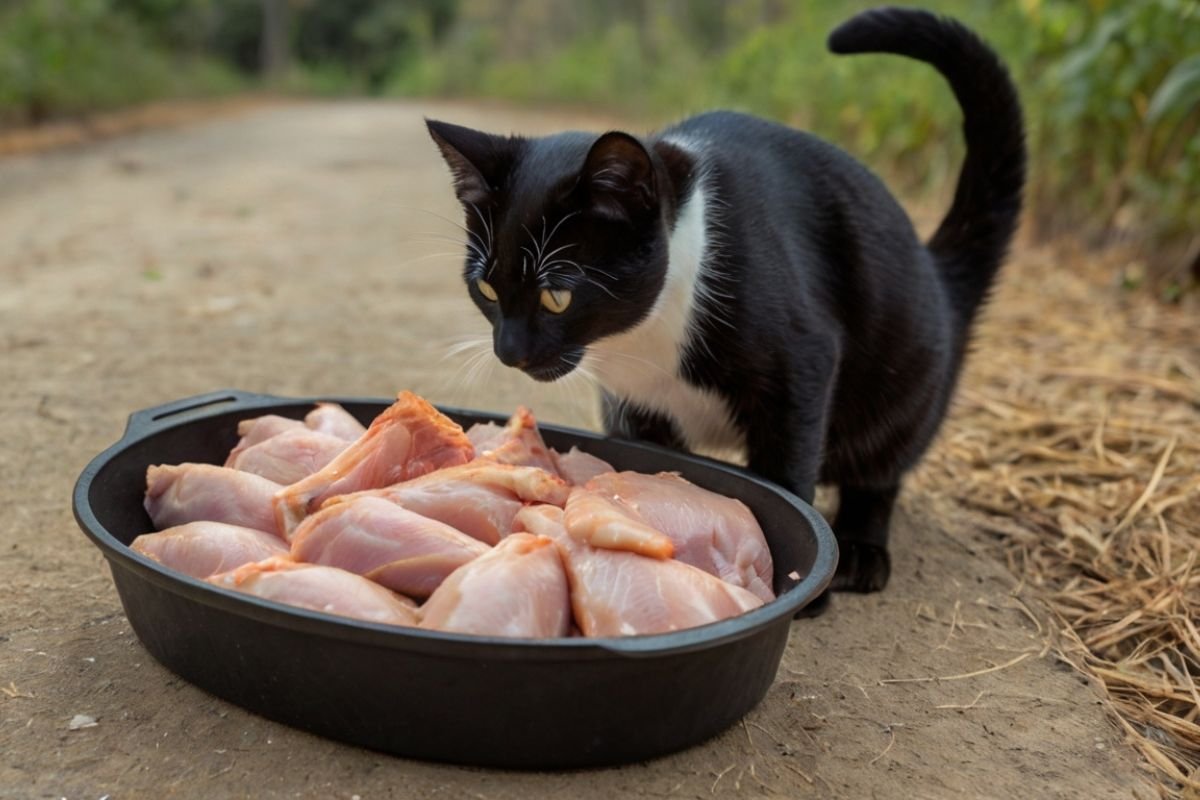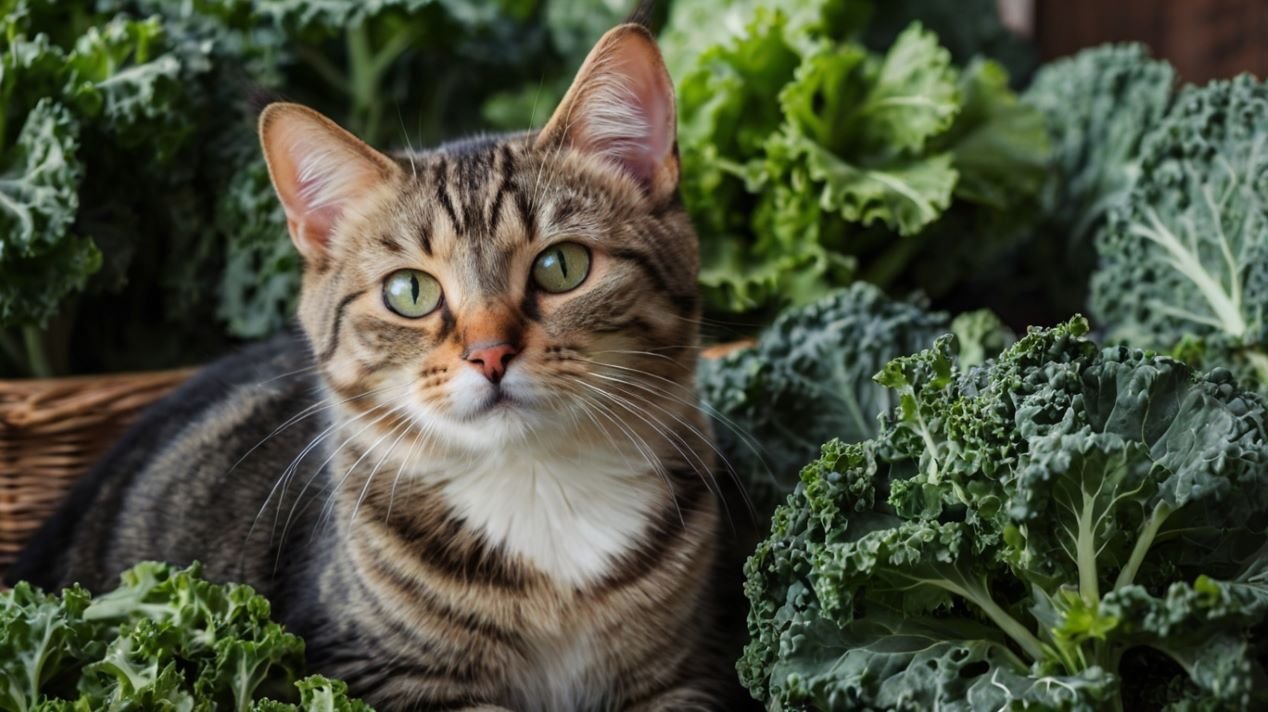One day, I was making myself a peanut butter sandwich when I noticed my orange tabby, Rio, watching my every move with those big curious eyes. His tail twitched with interest as I spread the creamy goodness onto my bread. It got me thinking – can cats eat peanut butter? Is it safe? Would Rio enjoy it as much as I do?
If you’ve ever caught your cat eyeing your peanut butter toast or wondered if this common human treat could be shared with your feline friend, you’re not alone. Many cat owners ask this same question.
Peanut butter is a staple in many human diets. We use it in sandwiches, baking, and even as a quick protein-packed snack. But what’s good for us isn’t always good for our feline friends. Our cats have very different dietary needs than we do.
In this blog post, we’ll dig deep into whether cats can eat peanut butter safely. We’ll look at the good, the bad, and the sticky situations that might come up if you share this treat with your cat. By the end, you’ll know if that dollop of peanut butter is a yes, no, or maybe for your furry friend.
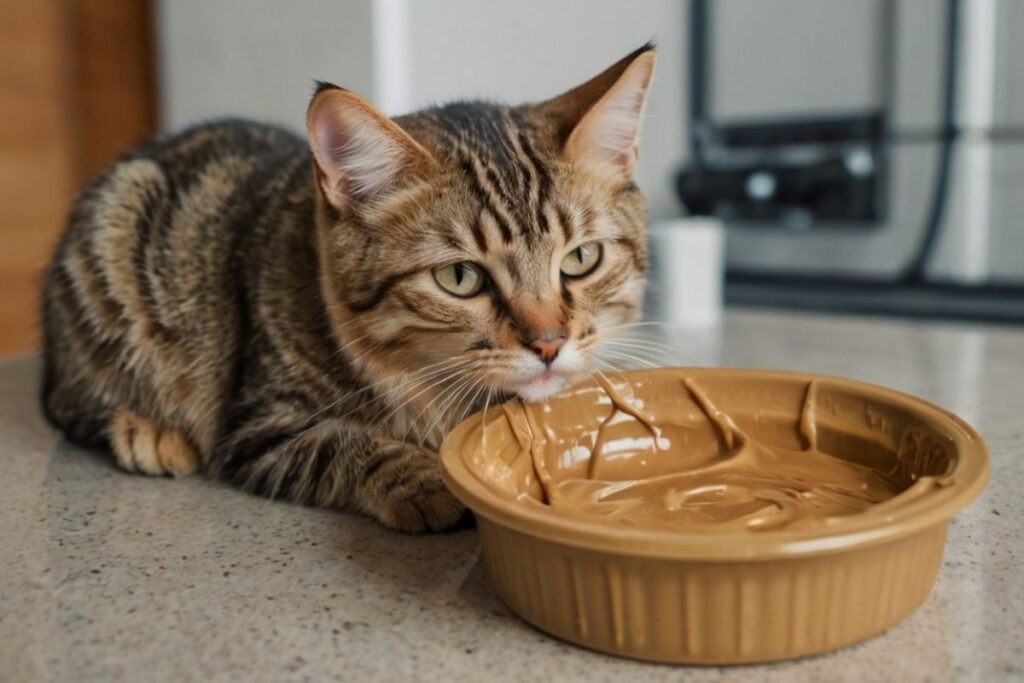
Table of Contents
Can Your Cats Eat Peanut Butter?
Let’s start with the simple answer: Yes, cats can eat peanut butter, but they shouldn’t eat much of it, and many cats shouldn’t eat it at all.
Peanut butter isn’t toxic to cats like some foods are (think chocolate or onions). A tiny lick won’t send you rushing to the vet. But that doesn’t mean it’s good for them.
Cats are what we call “obligate carnivores.” This fancy term means they need meat to live and thrive. Their bodies are set up to get energy and nutrients from animal proteins. Plants just aren’t on their natural menu.
Rio, like all cats, has a body that works best on meat. His wild ancestors didn’t stop to munch on peanuts while hunting. They went for mice, birds, and other small prey. Our house cats still have the same basic needs, even if they now eat from bowls rather than hunt.
Peanut butter offers little to no real value to cats. It’s high in fat and often has added sugar and salt – none of which cats need or process well.
Also read, Can Cats Eat Blueberries?
What’s In Peanut Butter? Breaking Down the Ingredients
To understand why peanut butter isn’t ideal for cats, let’s look at what’s in it:
- Peanuts: The main ingredient, these are plant proteins that cats’ bodies aren’t made to digest well.
- Oils: Peanut butter contains fats, which cats do need in their diet but get better from animal sources.
- Salt: Many brands add salt, which can be bad for cats in large amounts.
- Sugar: Some brands add sugar or honey, which cats don’t need at all.
- Xylitol: Some “natural” or low-sugar brands use this sweetener, which is TOXIC to dogs and possibly cats too.
The biggest red flag is xylitol. If your peanut butter has this (check the label for “xylitol” or “sugar alcohol”), keep it far away from all pets. It can cause a dangerous drop in blood sugar and liver damage in dogs, and we suspect it may harm cats too.
Even natural, unsweetened peanut butter with just peanuts and maybe salt isn’t great for cats. It’s still a plant protein they can’t use well, and it’s very calorie-dense.
Potential Health Risks of Peanut Butter for Cats
Giving your cat peanut butter isn’t just unhelpful – it could cause problems:
1. Digestive Upset
Cats’ stomachs aren’t made to handle peanut butter. Eating it can lead to:
- Vomiting
- Diarrhea
- Stomach pain
- Gas
Once, I gave Rio the tiniest bit of peanut butter as a treat. While he seemed to enjoy the taste, his tummy did not thank me later. The messy aftermath was not worth those few seconds of his curious enjoyment.
2. Weight Gain and Obesity
Peanut butter packs a lot of calories into a small serving. Just one tablespoon has about 100 calories! For a cat who might only need 200-300 calories a day, that’s a huge chunk of their daily intake with no real nutrients.
Obesity in cats leads to:
- Joint problems
- Diabetes
- Heart issues
- Shorter lifespan
3. Choking Hazard
Peanut butter is sticky and thick. Cats don’t chew the same way we do, and their mouths are smaller. The thick, sticky nature of peanut butter can make it hard for them to lick and swallow properly.
This sticky texture can:
- Stick to the roof of their mouth
- Be hard to swallow
- Cause panic if they can’t clear it
- Lead to choking in worst cases
4. Allergic Reactions
Just like humans, cats can have food allergies. Signs of an allergic reaction include:
- Itchy skin
- Ear infections
- Hair loss
- Face swelling
- Trouble breathing (in severe cases)
If you see any of these after your cat has peanut butter, call your vet right away.
5. Xylitol Poisoning
As mentioned earlier, some peanut butters contain xylitol, which is very dangerous for pets. If your cat eats peanut butter with xylitol, watch for:
- Vomiting
- Weakness
- Lack of coordination
- Seizures
This is an emergency – get to a vet right away if you suspect xylitol poisoning.
Why Do Some Cats Like Peanut Butter?
With all these risks, you might wonder why some cats seem to like peanut butter. The answer lies in fat content.
Cats are drawn to fats because in nature, fatty foods are high in calories and help survival. Their taste buds can detect fats and find them rewarding.
Also, cats are often curious about what we eat. If they see us enjoying something, they want to check it out too. It’s not about the peanut butter itself, but about joining in on what looks like a good thing.
Rio often shows interest in whatever I’m eating. It’s not that he truly wants my peanut butter toast – he’s just curious and wants to be part of the action.
How Much Peanut Butter Can Cats Have?
If you’ve read this far and still want to give your cat a taste of peanut butter, here are some guidelines:
- Only use plain, unsalted peanut butter with NO xylitol
- Limit it to a pea-sized amount (about 1/8 teaspoon)
- Give it rarely – not daily or even weekly
- Watch for any bad reactions
- Don’t give any if your cat has health issues like diabetes or weight problems
Think of peanut butter as a once-in-a-while tiny taste, not a regular treat.
Better Alternatives to Peanut Butter for Cats
Instead of peanut butter, why not try treats that are better suited to cats? Here are some ideas:
Commercial Cat Treats
Many store-bought cat treats are:
- Made with meat proteins cats can use
- Sized right for cats
- Formulated to be safe
- Often helpful for teeth or other health needs
Homemade Meat Treats
You can make simple treats by:
- Baking small bits of chicken, turkey, or fish
- Freezing tiny bits of cooked meat
- Using plain meat baby food (check for no onions or garlic)
Cat-Safe Human Foods
Some human foods make better treats than peanut butter:
- Small bits of cooked chicken or turkey
- Tiny pieces of plain cooked fish
- A lick of plain yogurt (some cats can handle small amounts)
Remember that treats should make up no more than 10% of your cat’s daily calories. The other 90% should come from complete, balanced cat food.
Using Peanut Butter for Medicine
One common use for peanut butter with pets is hiding pills. While this works well for dogs, it’s not the best choice for cats.
Better options for giving cats medicine include:
- Pill pockets made for cats
- Special treats designed to hide pills
- Pill givers (tools that help you place the pill at the back of their throat)
- Asking your vet if the medicine comes in liquid form
If you must use peanut butter to give medicine, use the smallest amount possible and only when needed.
What to Do If Your Cat Eats Too Much Peanut Butter
If your cat somehow gets into a jar of peanut butter or eats more than a tiny taste, here’s what to do:
- Check the ingredients to see if it contains xylitol (if yes, go to the vet right away)
- Watch for signs of distress, like vomiting, diarrhea, or lethargy
- Make sure fresh water is available
- Call your vet if you notice any concerning symptoms
- Do not try to make your cat throw up unless a vet tells you to
Most cats will be okay after eating a small amount of plain peanut butter, but it’s always better to be safe.
Understanding Your Cat’s Natural Diet
To better understand why peanut butter isn’t great for cats, it helps to know what cats should eat.
In the wild, cats eat:
- Muscle meat from prey
- Organ meats like liver
- Some bone matter
- Very small amounts of plant material (from prey stomachs)
This diet gives them:
- High protein (40-50% of diet)
- Moderate fat (30-40%)
- Very low carbohydrates (1-2%)
- Key nutrients like taurine that they can’t make themselves
House cats have the same basic needs. Good cat foods try to match this pattern and add vitamins and minerals cats need to stay healthy.
Peanut butter, with its plant-based protein and high fat content, just doesn’t fit into what cats’ bodies need or can use well.
The Psychology of Sharing Food With Pets
Many of us want to share our favorite foods with our pets. It feels like a way to bond and show love. I get it – when Rio looks at me with those big hopeful eyes while I eat, it’s hard to say no.
But showing love through food doesn’t have to mean sharing everything we eat. In fact, the most loving thing is often to say “no” to foods that might harm our pets.
We can show love by:
- Giving treats made for cats that they’ll enjoy and that won’t harm them
- Spending time playing with them
- Brushing them if they enjoy it
- Simply being present with them
Rio doesn’t need my peanut butter to know I care. He’s much happier with a proper cat treat and some play time with his favorite feather toy.
What About Other Nut Butters?
If peanut butter isn’t great for cats, what about almond butter, cashew butter, or other alternatives?
The short answer is that they’re all about the same in terms of being unsuitable for cats. All nut and seed butters:
- Are plant proteins cats can’t use well
- Have high fat content
- Often contain added salt or sweeteners
- Provide no nutritional benefit to cats
Whether it’s peanut, almond, cashew, or sunflower seed butter, the advice is the same: it’s best to skip sharing these with your cat.
Common Questions About Cats and Peanut Butter
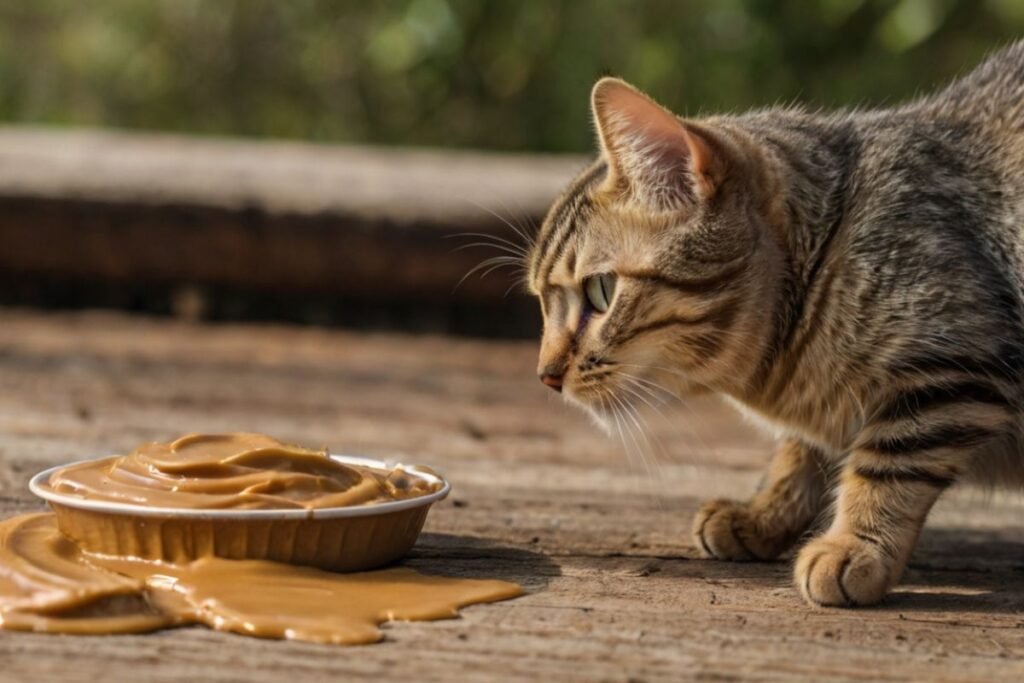
Let’s address some questions cat owners often ask about peanut butter:
Can peanut butter help with hairballs?
No. While some people think the sticky texture might help move hairballs through, there’s no evidence for this. Better hairball remedies include:
- Special hairball-control cat foods
- Regular brushing to remove loose fur
- Cat-specific hairball remedies from your vet
Can I use peanut butter to distract my cat during grooming?
It’s not the best choice. The cat will focus on trying to clean the sticky substance from their mouth rather than staying still. Better options include:
- Having a second person gently hold the cat
- Using special cat treats that are eaten quickly
- Keeping grooming sessions short and positive
Is peanut butter good for getting pills into cats?
Not really. Most cats don’t eat enough peanut butter to hide a pill well, and the stickiness can make it harder, not easier. Pill pockets made for cats work much better.
Will a tiny bit of peanut butter hurt my cat?
A truly tiny amount (smaller than a pea) of xylitol-free peanut butter rarely causes problems in healthy cats. But there’s also no benefit, so why take the risk?
My cat licked peanut butter before I read this – should I be worried?
If it was just a small lick of regular peanut butter (no xylitol), your cat will likely be fine. Just watch for any upset stomach and don’t make it a habit.
Making Informed Choices About Cat Treats
When choosing treats for your cat, it helps to have some guidelines:
What to Look For:
- High meat content
- Few ingredients
- No artificial colors or flavors
- Treats sized appropriately for cats
- Treats that serve a purpose (dental health, hairball control)
What to Avoid:
- High carbohydrate content
- Added sugars
- Artificial preservatives
- Human foods not meant for cats
- Treats that make up too much of their diet
Remember that even the best cat treats should be limited to about 10% of your cat’s daily calories.
Special Considerations for Some Cats
Some cats need to be extra careful about treats like peanut butter:
Senior Cats
Older cats often have:
- Slower digestion
- Kidney issues
- Dental problems
- Less ability to handle dietary changes
Cats With Health Conditions
Skip peanut butter entirely if your cat has:
- Diabetes
- Pancreatitis
- Food allergies
- Kidney disease
- Obesity
Kittens
Young cats like Rio when I first got him:
- Need nutrient-dense foods for growth
- Have sensitive digestive systems
- Can develop bad food habits early
- Need to learn to eat proper cat food
Conclusion: The Peanut Butter Verdict
After looking at all the facts, the answer to “Can cats eat peanut butter?” is:
Technically yes, they can eat a tiny bit without immediate harm (as long as there’s no xylitol). But they shouldn’t, because:
- It has no nutritional value for them
- It poses several health risks
- There are much better treat options
- Cats simply don’t need it
As cat owners, we want to do what’s best for our feline friends. Sometimes that means keeping our peanut butter to ourselves, no matter how curious they may be.
Rio may still watch me make my peanut butter sandwiches with great interest, but I know that sharing isn’t always caring when it comes to human foods and our pets. Instead, I’ll reach for his cat treats that I know are safe and healthy for him.
What about your cat? Have you ever shared peanut butter or found better alternatives? Remember that the best treats are those made with our cats’ unique needs in mind.
Our cats trust us to make good choices for them. Let’s make sure we honor that trust by feeding them what their bodies are designed to eat, not just what they seem curious about.
And if you’re ever in doubt about what foods are safe for your cat, it’s always best to check with your veterinarian. They can give you guidance specific to your cat’s health needs and help you choose the best diet and treats for your feline friend.

Shahriar Robin is the creator of WhatPetsCanEat.com, a passionate pet lover and dedicated cat dad to Rio, a curious two-year-old orange feline who inspired this website. With a love for animals and a knack for research, Shahriar shares trusted, easy-to-understand information to help fellow pet owners make safe, healthy food choices for their furry friends.
